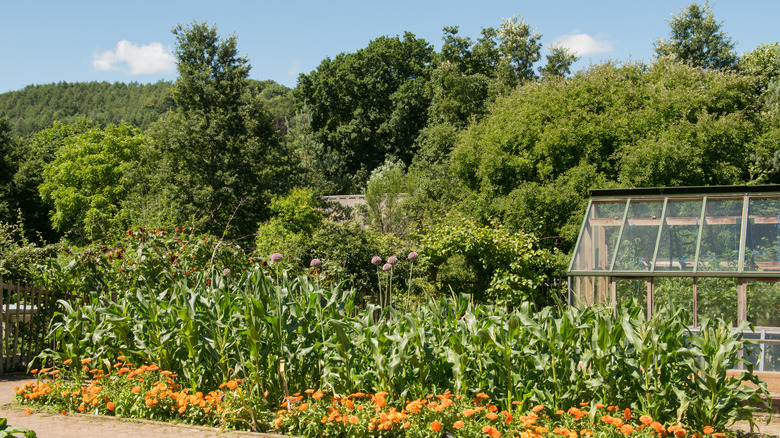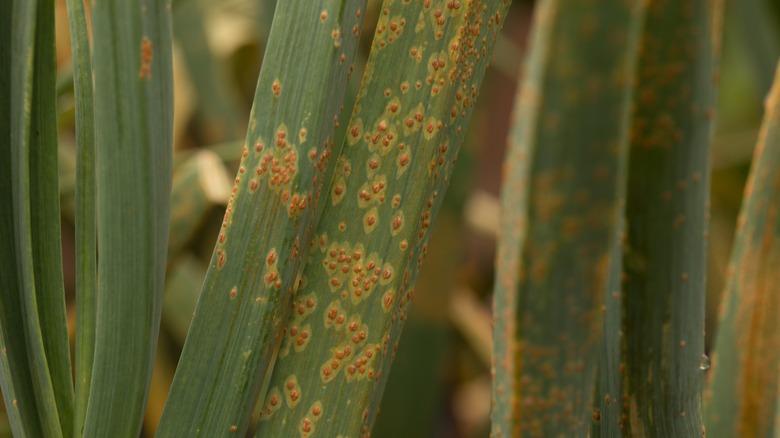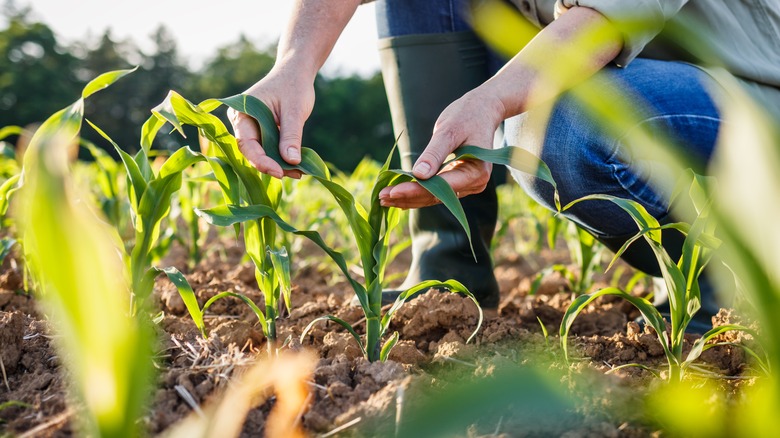Are Corn And Garlic Truly Unfriendly Garden Neighbors?
There's this idea propagated by garden bloggers and green-thumbed influencers that you shouldn't plant corn and garlic together. However, dig a little deeper into the conversation around this supposedly ill-fated partnership, and you'll find the assertion is muddy at best. Garlic and corn might be problematic partners in your garden beds, but more likely than not, you'll get away with planting them together just fine. As with many gardening conundrums, if you want to grow your own garlic next to (or even among) your cornstalks, the best way to find out if they work is to try it out for yourself. But first, let's dig into the research around this controversial topic.
The garlic-corn concern may stem from beans and corn being fruitful partners in the garden. In the Three Sisters, an Indigenous American companion planting method, beans, corn, and squash are planted together, forming a symbiotic relationship. However, beans are a type of legume, and the plants in this family don't do well when planted next to garlic. "Peas, beans, melon, and asparagus should not be planted next to garlic, as the potent garlic will actually stunt its neighbor's growth," Houston-based garden guru Jennifer McDonald informs Homes & Gardens readers. In other words, if you have beans running up your corn, you won't be able to plant garlic nearby.
Pest problems
Corn borers, a common corn pest, have been known to predate garlic after the scapes are removed, according to a 2016 article written by Dr. Ron Goldy for Michigan State University on garlic production in Michigan. A review article published in a 2018 issue of Frontiers in Plant Science states that corn is occasionally a "green bridge refuge" for Eriophyoid mites (one of the two subtypes of bulb mites). This means that mites living on the corn can migrate to their preferred plant species if planted nearby. Dry bulb mite, a member of this family, is a particular problem for garlic growers. Fertilizer manufacturer Down to Earth advises waiting four years after planting corn to plant garlic in the same plot.
Rusts, a group of fungal plant diseases, are also a concern for garlic and corn growers alike. However, the rust on corn, called common rust, differs from garlic rust, the most common type of rust that infects alliums, like garlic. A commenter on the blog post "Milk and Rust" by keen amateur gardener Patrick Wiebe asked if their garlic might have contracted rust from earlier corn or broad bean plantings. Wiebe says this is unlikely: "As far as I know, garlic rust is specific to garlic, and no other plants can be carriers of the disease." More troubling, corn may be a source of dry rot in garlic bulbs, according to a 2022 research paper published in Horticulturae.
Companion planting
Garlic is often celebrated by gardeners interested in companion planting for its ability to deter insects and other pests. For example, deer are a problem for some corn growers, with corn being a favorite food. They have an excellent sense of smell, and planting aromatics like garlic around your beds will discourage them. Garlic may also be a helpful fungicide. A 2021 study published in LWT found that garlic essential oil in gas and digestible form reduced fungal growth in stored corn kernels. Plus, corn is pollinated predominately by wind, so there's little need for pollinating insects in ear formation.
The growth habits of corn and garlic may have influenced this common gardening concern, too. For one, corn and garlic both require a fertilizer high in nitrogen; if both are planted in the same bed, feeding is easy. However, corn is also notoriously tall, with some varieties growing up to 12 feet. Garlic requires full sun — 8 to 10 hours a day, preferably — to produce sturdy bulbs. Planting seed bulbs near a patch of towering corn stalks may limit sun exposure.
American gardening authority Lee Reich suggests the only thing controversial about planting garlic and corn together is timing. In a 2014 article published on his blog, he says garlic needs to be planted in early fall to get the cool climate exposure it requires to develop hearty heads. Conversely, if you want your corn to thrive, planting should start in early May through June.


